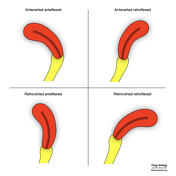Retroverted uterus
- Philips Australia, Paid speaker at Philips Spectral CT events (ongoing)
Updates to Article Attributes
A retroverted uterus is a normal variation of female pelvic anatomy in which the body of the uterus is tilted backwards (usually leans forward, i.e. anteverted) on itself to match the isthmus of the neck and lower uterine segment. There are variable grades of uterine retroversion.
Epidemiology
Retroverted uterus is common and is the normal uterine position in approximately 20% of all women. Its role as a cause of infertility is controversial.
Clinical presentation
The retroverted uterus almost never causes symptoms, although it is sometimes associated with dyspareunia and dysmenorrhoea. This This is thought to be because the retroverted position causes the uterus to approach the rectum and contact the posterior vaginal wall, mobilizationmobilisation of the uterus during sex generates pain (sometimes very severe) especially if the uterus is fixed in that position.
Atypical positioning of the uterus may be caused by:
- endometriosis
- salpingitis
- pressure from a growing tumour
These conditions should be ruled out in a patient with pain or other symptoms.
Treatment and prognosis
Complications
The retroverted uterus may have a higher incidence of threatened abortion, because at the beginning of pregnancy, the uterus has to rotate completely to grow in the abdominal cavity 3.
-<p>A<strong> retroverted uterus </strong>is a normal variation of female pelvic anatomy in which the body of the <a href="/articles/uterus">uterus</a> is tilted backwards (usually leans forward, i.e. anteverted) on itself to match the isthmus of the neck and lower uterine segment. There are variable grades of uterine retroversion.</p><h4>Epidemiology</h4><p>Retroverted uterus is common and is the normal uterine position in approximately 20% of all women. Its role as a cause of infertility is controversial.</p><h4>Clinical presentation</h4><p>The retroverted uterus almost never causes symptoms, although it is sometimes associated with dyspareunia and dysmenorrhoea. This is thought to be because the retroverted position causes the uterus to approach the <a href="/articles/rectum">rectum</a> and contact the posterior <a href="/articles/vagina">vaginal</a> wall, mobilization of the <a href="/articles/uterus">uterus </a>during sex generates pain (sometimes very severe) especially if the uterus is fixed in that position.</p><p>Atypical positioning of the uterus may be caused by:</p><ul>- +<p>A<strong> retroverted uterus </strong>is a normal variation of female pelvic anatomy in which the body of the <a href="/articles/uterus">uterus</a> is tilted backwards (usually leans forward, i.e. anteverted) on itself to match the isthmus of the neck and lower uterine segment. There are variable grades of uterine retroversion.</p><h4>Epidemiology</h4><p>Retroverted uterus is common and is the normal uterine position in approximately 20% of all women. Its role as a cause of infertility is controversial.</p><h4>Clinical presentation</h4><p>The retroverted uterus almost never causes symptoms, although it is sometimes associated with dyspareunia and dysmenorrhoea. This is thought to be because the retroverted position causes the uterus to approach the <a href="/articles/rectum">rectum</a> and contact the posterior <a href="/articles/vagina">vaginal</a> wall, mobilisation of the <a href="/articles/uterus">uterus </a>during sex generates pain (sometimes very severe) especially if the uterus is fixed in that position.</p><p>Atypical positioning of the uterus may be caused by:</p><ul>
Image 2 Diagram ( create )

Image 3 MRI (T2) ( update )

Image 4 CT (C+ portal venous phase) ( update )

Image 5 MRI (T2) ( update )








 Unable to process the form. Check for errors and try again.
Unable to process the form. Check for errors and try again.